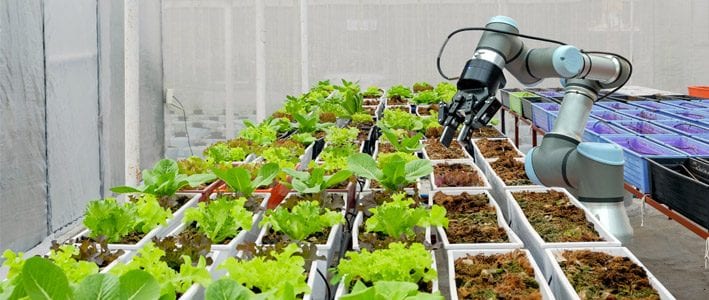© chiradech / Adobe Stock
The world’s population has rocketed to 7.5 billion – so it comes as no surprise that technology is transforming the food industry to meet ever-increasing demands. The use of tech in the processing and packaging of food can improve its shelf life, safety and quality.
Technology is playing an ever-growing role in the food journey, from farm to fork. The main developments include the increasing use of robotics and machines to speed up the production process, increase productivity and keep the food fresh for longer.
One recent tech development is 3D printing, which is opening the door to creating food products that weren’t possible before, while also helping with food sustainability. Other developments include precision agriculture using drones and robotics, and digitising to reduce waste and find alternatives to harmful packaging like plastic.
Fruit and vegetables
Technology is benefiting the production of numerous different types of food. In Japan, farming without soil has become a reality, thanks to new tech aimed at growing fruit and vegetables in almost any environment. Scientists are using polymer film to grow food in the Mebiol Research and Development Centre.
Seedlings are cultivated on top of the thin, transparent film. The cutting-edge farming method means any type of fruit and vegetable can be grown on almost any flat exterior. The film is made of the absorbent material, hydrogel, which is normally used in products such as disposable nappies.
It soaks up water and nutrients via nano-sized pores, which are only one-millionth of a millimetre across. Instead of the plants’ roots going into the ground, they spread across the film’s surface instead.
Chemical physicist Yuichi Mori has invented the process and believes it can help solve some of the challenges facing the agriculture sector. A study by the Grantham Centre at the University of Sheffield reveals earth has lost one-third of its arable land in the past 40 years, as a result of pollution and erosion.
Effects of heavy fertilisers and over-cultivation have depleted soil faster than it can be replenished, with climate change accelerating the erosion. Scientists estimate food production must increase by 50% by 2050, when there will be three billion more people to feed.
Mori believes his method is an eco-friendly, viable alternative to growing crops in soil. It is also possible to study the plants close-up (including the roots) as they grow, so that their health can be continually monitored.
Meat industry
Using machines in the food industry increases productivity and drives down the cost of keeping the food fresh. Research says more than 30,000 robots are used in the European food industry, with the number of robots rising from 62 per 10,000 employees in 2013 to 84 in 2017.
Germany, Sweden, the Netherlands, Denmark and Italy currently use the most robots. One of the biggest sectors for robot-use is the meat industry – they help solve safety issues for the more dangerous jobs. Technology moved forward in 2016 to introduce robots to cut the meats.
Using the tech for the most difficult cuts meant work injuries in butchery were reduced. In the past, cutting, de-boning and shredding meat was done by hand, but automation has begun to take over. The robotic automation is built to withstand moisture, rust and other elements that may cause corrosion.
3D printers
Although printing your own food sounds like something out of a science fiction film, it’s actually happening. The technology used in 3D printing has benefited many industries, including food production.
NASA has been researching printing foods for astronauts and one of the most surprising innovations is a 3D printed pizza produced by the Systems and Materials Research Corporation.
There have been several applications for 3D food-printing. Scientists have also created soft foods to help people who can’t chew hard foods, or find them hard to digest. They believe 3D printing can help with food sustainability.
Drones
Precision agriculture is a prime example of technology making a difference in food production. A system using drones, GPS tracking systems and satellite imagery will monitor soil levels, crop yields and weather patterns to improve the efficiency of crop cultivation on farms.
Drones enable the operators to see everything that’s happening in several fields at the touch of a button, rather than using the old-fashioned method of walking and manually checking the crops. Analysing the drones’ data enables farmers to test the soil and assess the health of the crop.
The drones can also spray with fertilisers and pesticides, while enabling farmers to assess whether crops are damaged by pests or disease, so they can resolve the problem immediately.
Drones can be used in vineyards as well. They don’t eliminate the need for agricultural workers altogether, but rather improve the efficiency of the operation. When working with large volumes of crops, with strict product requirements, precision farming with drones can produce the food more quickly, in a continuously-monitored environment.
Self-driving vehicles
In the same way that drones can monitor and spray crops, automated tractors will enable farmers to produce more crops faster. A number of fields can be worked simultaneously, using the same number or less workers.
Tractors are controlled and monitored remotely, freeing up workers to carry out other tasks. They make it possible for work to be carried out seven days a week, 24 hours a day. Farms can also use water more efficiently with automated irrigation systems, which will collect data about the soil and water levels.
Farmers are always battling changes in the weather, but scientists say that in future, the latest technology will enable them to complete their whole harvest using automated vehicles. This means that if a change in the weather is imminent, it will be time to “send in the big boys”, in terms of harvesting machinery that can get the job done in record time.
Reducing waste
Consumers are increasingly concerned about buying healthy and sustainable goods, as warnings about waste are starting to get through to people. Shoppers are paying attention to labels and looking out for food items that will help them to “go green”.
One of the biggest issues in recent years has been trying to reduce the amount of waste packaging, such as plastics, which are damaging the environment when not properly disposed of or recycled. Using robotic and digital tech is creating innovative new products, such as edible packaging, micro-packaging and even packaging that helps to fight bacteria.
In the United States, research shows that 40% of food is thrown away annually. Now, new technology is being created to ensure the extra food doesn’t go to waste. Apps are under development to create a food waste reduction dashboard.
Businesses who have surplus food will be able to get in touch with local shelters, charities and after-school programmes, via the app, to make sure the food goes to the people who need it. Surplus is managed and tracked by analytical software, which helps businesses to reduce overall food waste and save money.
With the many advances in technology, there are a multitude of ways that can transform the way we produce food. It could be the key to eliminating world hunger, coping with the dietary needs of a growing population and solving our waste problem.
Controlling temperatures
A crucial part of the food production industry is keeping the produce at the correct temperature so that it remains cold, free from bacteria and lasts longer. 1COLD specialises in the design, construction and project management of temperature-controlled environments.
We produce a high-quality range of cold rooms, industrial chillers and cold stores for the food and drink industry. Please contact us for more information.




